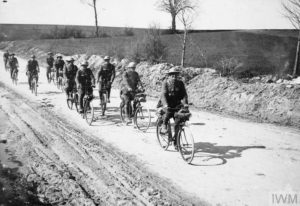Sunday September 29th, 1918
Left Corbie (Somme) 9 o’clock for unknown destination. Arrived Proyart 4 o’clock. Dead tired. Awful destruction in an awful battered house.
Proyart
The Battalion arrives in Proyart today. The region is clearly battered by war and Frank seems to be billeted in a wreck of a house.
The Operation Order No 4 which dictates the moves to Proyart was issued yesterday. The Battalion will set off at 10:30. Each soldier will carry ‘haversack rations’ with filled water bottles. There will be no opportunity to halt at midday.
An advance party led by Lt KH Allen and comprising the CQMS of each company will leave on bicycles at 9am in order to meet the Staff Captain at Proyart Church at 11am.
Bicycles in WWI
By the late 19th century, bicycles were being used by armies across the world. Their attractions were obvious:

‘They were cheap to manufacture, easy to maintain (and unlike horses) required no feed, water or care, yet bicycles allowed foot soldiers much of the same mobility enyoyed by the cavalry and at a fraction of the cost. Bike riding infantry could carry heavier loads farther and faster than men on foot, and riders would still have the energy to charge into battle, even after hours of pedalling.’¹
In Britain they were used by both the Expeditionary Forces on all fronts and the Territorials for domestic service. The British Army established an overarching Cyclist Corps. Initially this controlled the cyclist companies that existed within each infantry division. However in mid-1916, these divisional units were disbanded and instead each Corps HQ was assigned a cyclist battalion.
The Role of Cyclists in WWI

Their specialist role was reconnaissance and communications. However they were also trained infantry and frequently used in this capacity. The photograph shows a British cyclist patrol on the Toutencourt-Contay road in April 1918.
‘It’s not easy to determine how many men served in the various cyclist units. Some 20,000 names can be traced from the campaign medal rolls, but this does not include the many who served in cyclist units at home. The records of the Commonwealth War Graves Commission list 862 men of the Army Cyclist Corps who lost their lives in WW1; they lie or are commemorated in every theatre of war in which the British army was present.’ ³
Today the Battalion is using a fleet of bicycles to rendezvous in Proyart in advance of the arrival of the main body.
9th Battalion War Diary – 29th September 1918 – Manin
Battalion moved to Proyart.
References & Further Reading
¹ ‘Two-wheeled warrior’ on Military History Now
² ‘Army Cyclist Corps‘ on The Long Long Trail
³ ‘War on Two Wheels: British Army Cyclists 1914-1918‘ by Chris Baker (of the Long, Long Trail), in The Gazette
* Q 369, copyright Imperial War Museums
^ Q 78763, copyright Imperial War Museums


